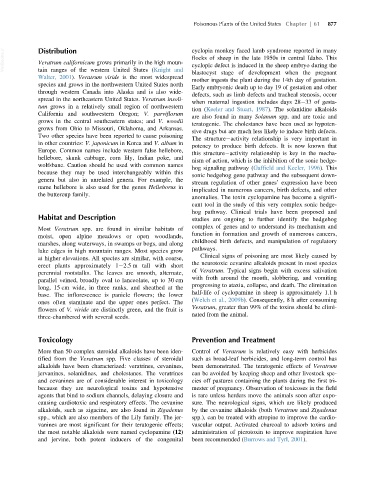Page 923 - Veterinary Toxicology, Basic and Clinical Principles, 3rd Edition
P. 923
Poisonous Plants of the United States Chapter | 61 877
VetBooks.ir Distribution cyclopia monkey faced lamb syndrome reported in many
flocks of sheep in the late 1950s in central Idaho. This
Veratrum californicum grows primarily in the high moun-
cyclopic defect is induced in the sheep embryo during the
tain ranges of the western United States (Knight and
blastocyst stage of development when the pregnant
Walter, 2001). Veratrum viride is the most widespread
mother ingests the plant during the 14th day of gestation.
species and grows in the northwestern United States north
Early embryonic death up to day 19 of gestation and other
through western Canada into Alaska and is also wide-
defects, such as limb defects and tracheal stenosis, occur
spread in the northeastern United States. Veratrum insoli-
when maternal ingestion includes days 28 33 of gesta-
tum grows in a relatively small region of northwestern
tion (Keeler and Stuart, 1987). The solanidine alkaloids
California and southwestern Oregon; V. parviflorum
are also found in many Solanum spp. and are toxic and
grows in the central southeastern states; and V. woodii
teratogenic. The cholestanes have been used as hypoten-
grows from Ohio to Missouri, Oklahoma, and Arkansas.
sive drugs but are much less likely to induce birth defects.
Two other species have been reported to cause poisoning
The structure activity relationship is very important in
in other countries: V. japonicum in Korea and V. album in
potency to produce birth defects. It is now known that
Europe. Common names include western false hellebore,
this structure activity relationship is key in the mecha-
hellebore, skunk cabbage, corn lily, Indian poke, and
nism of action, which is the inhibition of the sonic hedge-
wolfsbane. Caution should be used with common names
hog signaling pathway (Gaffield and Keeler, 1996). This
because they may be used interchangeably within this
sonic hedgehog gene pathway and the subsequent down-
genera but also in unrelated genera. For example, the
stream regulation of other genes’ expression have been
name hellebore is also used for the genus Helleborus in
implicated in numerous cancers, birth defects, and other
the buttercup family.
anomalies. The toxin cyclopamine has become a signifi-
cant tool in the study of this very complex sonic hedge-
hog pathway. Clinical trials have been proposed and
Habitat and Description studies are ongoing to further identify the hedgehog
complex of genes and to understand its mechanism and
Most Veratrum spp. are found in similar habitats of
function in formation and growth of numerous cancers,
moist, open alpine meadows or open woodlands,
childhood birth defects, and manipulation of regulatory
marshes, along waterways, in swamps or bogs, and along
pathways.
lake edges in high mountain ranges. Most species grow
at higher elevations. All species are similar, with coarse, Clinical signs of poisoning are most likely caused by
erect plants approximately 1 2.5 m tall with short the neurotoxic cevanine alkaloids present in most species
of Veratrum. Typical signs begin with excess salivation
perennial rootstalks. The leaves are smooth, alternate,
with froth around the mouth, slobbering, and vomiting
parallel veined, broadly oval to lanceolate, up to 30 cm
progressing to ataxia, collapse, and death. The elimination
long, 15 cm wide, in three ranks, and sheathed at the
half-life of cyclopamine in sheep is approximately 1.1 h
base. The inflorescence is panicle flowers; the lower
(Welch et al., 2009b). Consequently, 8 h after consuming
ones often staminate and the upper ones perfect. The
Veratrum, greater than 99% of the toxins should be elimi-
flowers of V. viride are distinctly green, and the fruit is
nated from the animal.
three-chambered with several seeds.
Toxicology Prevention and Treatment
More than 50 complex steroidal alkaloids have been iden- Control of Veratrum is relatively easy with herbicides
tified from the Veratrum spp. Five classes of steroidal such as broad-leaf herbicides, and long-term control has
alkaloids have been characterized: veratrines, cevanines, been demonstrated. The teratogenic effects of Veratrum
jervanines, solanidines, and cholestanes. The veratrines can be avoided by keeping sheep and other livestock spe-
and cevanines are of considerable interest in toxicology cies off pastures containing the plants during the first tri-
because they are neurological toxins and hypotensive mester of pregnancy. Observation of toxicoses in the field
agents that bind to sodium channels, delaying closure and is rare unless herders move the animals soon after expo-
causing cardiotoxic and respiratory effects. The cevanine sure. The neurological signs, which are likely produced
alkaloids, such as zigacine, are also found in Zigadenus by the cevanine alkaloids (both Veratrum and Zigadenus
spp., which are also members of the Lily family. The jer- spp.), can be treated with atropine to improve the cardio-
vanines are most significant for their teratogenic effects; vascular output. Activated charcoal to adsorb toxins and
the most notable alkaloids were named cyclopamine (12) administration of picrotoxin to improve respiration have
and jervine, both potent inducers of the congenital been recommended (Burrows and Tyrl, 2001).

